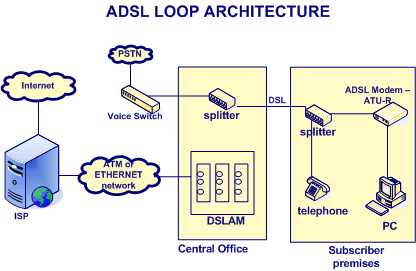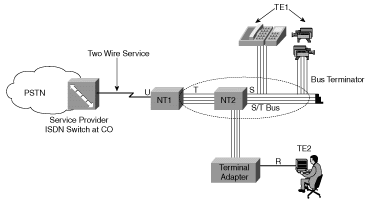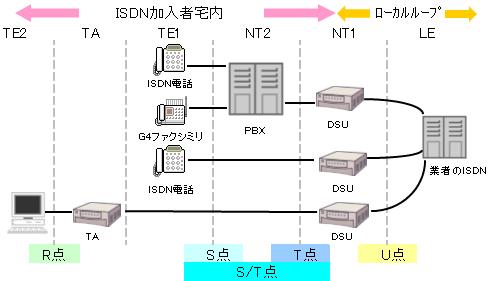WAN links
xDSL
use existing local loop line with xDSL (DSP) equipment at both ends.
use high frequencies (10KHz to 1.1MHz) not used by POTS.
upstream and downstream bands separated into many channels, each used
if its SNR is good.
point-to-point always-on link.
dependent on distance from CO restrictions, wire gauge and line quality (interference).
variants: HDSL, SDSL, ADSL, VDSL etc up to 10 Mbps?
HDSL for business WAN links (replace T1), ADSL for ISP users.
asymmetrical variants due to greater crosstalk from customer at CO
(NEXT due to hi freq attenuation)
and typical usage patterns.
ADSL originally planned for video on demand but instead broadband Internet access.
all 4 pins/wires of RJ11 used.


ATU-R is DSL modem.
PC/LAN--[router]---ATU-R--[splitter]---PSTN---DSLAM--ISP
dry loop/"naked" DSL: w/out POTS.
ADSL modem router
ADSL USB modem
DSL modem
close to CO: 200Mbps down, 20Mbps up
HFC (Cable modem, CATV Internet access)
CATV network (MAN?) upgraded to hybrid fiber-coax, added digital streams for
non-symmetrical downstream and upstreams.
home: upstream 384 Kbps to 6 Mbps, downstream to 15 Mbps
business: 3 - 30 Mbps
ISP/Internet--CMTS at headend--optical node--coax tree-and-branch
backbone--tap--splitter--RG6/RG11 75 Ohm F-type connector--cable modem--PC/LAN
HFC
CMTS
Cable modem connected to router
Cable modem connected to router
 DOCSIS says how system works
DOCSIS says how system works
cable modem as bridge (and router). tunes to downstream channel,
demodulates it, extracts only portion of data for it, converts to
Ethernet (or USB). upstream: receives Ethernet or USB signal,
modulates onto upstream channel, negotiates with headend CMTS to send.
shared medium: headend allocates time slots (TDM) to modems needing to send
data.
DHCP from headend. encryption. modem authentication.
peak usage slowdowns reduced by redundant and fiber ?
analog TV channel uses 6 MHz (27 MBps) (inefficiently). several MPEG-2 (6 MBPS) or MPEG-4 (2
MBPS) digital standard channels in one such carrier.
Higher capacity than DSL. Telcos counter with FTTH (fiber to the home/premises)
telcos and cable are competing for the triple play: telephone/voice,
television/video, Internet/data

MPLS




VPN
virtual private network: secure tunnel thru Internet. cheaper than leased line.
available everywhere. many-to-many connections.
site-to-site (L2L): replacement of private line.
remote access: VPN client on PC (or home router) or IPphone
IPSec:
negotiation: AH, ESP, ESP+AH
encryption: DES, 3DES, AES
authentication: MDS, SHA-1
protection: DH

Dying off?:
POTS of PSTN.
cust.premises -- analog local loop -- CO --digital, routed thru
exchanges' switches.
USA COs
RJ11, 2 pair copper twisted pair cable.
designed for voice traffic using analog signaling. 4 KHz bandwidth.
dial-up modem up to 56 Kbps
modem changes digital of computer to analog of local loop.
CCITT, now ITU, series of modem V. protocols.
includes compression and error detection, adjust speed to line conditions.
V.44/V.34 analog both ends. max 34 Kbps
V.90 V.92 you analog, ISP digital. 56 Kbps(download) can't get faster
PPP used for data link layer protocol
PSTN--|--RJ11--external modem -- serial port (w/ UART) as COMn
PSTN--|--RJ11--internal modem (w/ UART) as COMn
COM port = I/O address + IRQ
POTS to be subsumed into Internet??
Modem pool (282 modems)
Modem pool server
Modem pool location map
digitized voice: DS0 64Kbps (8000 Hz sampel rate @ 8 bits sample size)
ISDN
digital voice and data transmission over the local loop, thus higher
quality and speed and faster dialup than POTS.
Vision was end-to-end digital circuit-switched data network to replace
POTS.
Never popular in USA due to $ and install/reliabilty problems.
Now superseded by DSL.
basic rate interface BRI: two 64 Kbps B channels, one 16
Kbps D channel. 2B+D =128 Kbps
primary rate interface PRI: 23 64 Kbps B channels, one
64 Kbps D channel. 23B+D =1.5 Mbps (==T1, PRI as a repackaged T1)
B channels for data/voice, D channel for control.
reference points (interfaces): R S T U
PSTN--|-- U NT1 S/T -- TE1 (ISDN devices, e.g. phone/fax)
PSTN--|-- U NT1 S/T -- TA -- TE2 (non-ISDN device, e.g. PC)
terminal adapter is "ISDN modem"
NT1 and TA can be card
must be <18,000 ft from CO???
Dial-up service. per minute charges. usually PPP
usually SPID (telphone number) per B channel in BRI.


NT1
Leased line: permanent telphone connection of
predetermined constant bandwidth
between two locations, e.g. branch office and HQ.
T1 1.544 Mbps (24 64 Kbps DS0 channels)
fractional T1
T3 44.7 Mbps (672 channels, 28 T1s)
channel: one voice line or for data
T1 ~$1000/month
PSTN--|--CSU/DSU---router for data, PBX for voice
repeaters needed every 6000 ft?
PPP Layer 2 encapsulation/protocol:
--authentication (but not usually needed for point-to-point WAN link): CHAP.
--compression.
--callback to secure telephone number.
--multilink: combine multiple link into one. load-balancing too.
HDLC is another layer 2 encapsualtion protocol.
T1
CSU/DSU
Frame relay service.
good for bursty traffic.
LAN to LAN over WAN.
layer 2 encapsulation. LAPF encapsulation
variable bandwidths. CIR committed information rate is base, CBIR
committed burst information rate is guranteed during bursts.
Or? EIR is allowed if adequate bandwidth available.
not locked into rate and cost as with leased line.
efficient replacemnet of X.25
frame relay cloud ---|--FRAD---LAN
DTE (your router) ---- DCE (their switch)
virtual circuit in the cloud. PVC or rarely SVC.
DLCI (frame field) identifies the virtual connection (path thru the network). locally
significant only. multiple virtual circuits on same end-point (subinterfaces)
Native IP (eg. VPN, xDSL) displacing it. but useful for users beyond DSL etc
FRAD
ATM
another grand master plan (cf ISDN) that didn't quite make it.
network and data-link layer protocol.
virtual circuits, thus connection-oriented.
fixed-size "cells" (53 bytes, 5 byte header, 48 bytes data).
used in telco networks and Internet backbones but cost and complexity held back in
LANs. increased speed of IP-based networks eg. gigabit Ethernet also.
FDDI. 100 Mbps token-passing on shared medium, dual-ring
(reliability) LAN protocol using fiber-optic cable.
CDDI copper cable.
counter-rotating rings: primary ring normally carries data, secondary
idle until needed to replace down primary, or used also giving 200 Mbps.
frames up to 4500 B.
campus internetwork backbone.
ring and star topologies.
up to 100 km per ring?, 500? stations.
obsoleted by faster Ethernets.
NB. what "they" have:
the WAN traffic crossed
two systems: a 10 Gbps circuit from Sunnyvale
to Chicago and a 2.49 Gbps transatlantic circuit
between Chicago and Geneva.
(LANL, SLAC, CERN)
Abilene network of
"Internet2": consortium of 220 institutions and corporate partners. 10Gbps backbone. Goal of
100 megabit connectivity between every node by the end of 2006.
A private network used for education and research, is not entirely an
isolated network, since its members usually provide alternative access
to many of their resources through the public Internet. Abilene is not
technically part of the Internet since it does not peer with the
public Internet networks. Its NOC ishosted at Indiana University.
Uses Qwest's optical fiber networks.
 DOCSIS says how system works
DOCSIS says how system works








